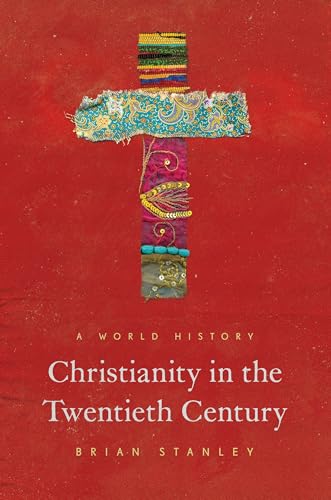Christianity in the Twentieth Century: A World History
Written by Brian Stanley Reviewed By Edward L. SmitherBrian Stanley, respected historian of world Christianity and professor at the University of Edinburgh, invested six years producing his latest work, Christianity in the Twentieth Century. Stanley’s two previous works—The World Missionary Conference, Edinburgh 2010 (Grand Rapids: Eerdmans, 2009) and The Global Diffusion of Evangelism (Downers Grove, IL: InterVarsity Press, 2013)—also explore issues of twentieth-century world Christian and mission history.
Stanley’s aim is to evaluate the “multiple and complex ways in which the Christian religion and its institutional embodiment in the Christian churches have interacted with the changing social, political, and cultural environment of the twentieth century” (pp. 3–4). To do this, he chooses fifteen themes that show how the church responded to the changing twentieth-century world, offering two case studies for each theme to make his point.
In the opening chapter, the author shows how British and American Christianity were affected by the First World War. Next, with a focus on Poland and Korea, he discusses the dynamics of Christianity and nationalism (ch. 2). The following three chapters consider prophetic and revival movements in Africa and the South Pacific (ch. 3), state-imposed secularization in France and the Soviet Union (chap. 4), and faith trends and church attendance in Scandinavia and the United States (ch. 5). He then explores church unity in India and China (ch. 6), racism in Nazi Germany, genocide in Rwanda (ch. 7), and the plight of Christian minorities in Egypt and Indonesia (ch. 8). Stanley continues his study by articulating twentieth-century mission theologies (ch. 9), exploring liberation theology in Latin America and Palestine (chap. 10), and discussing justice and the gospel issues in South Africa’s apartheid state and among Canada’s first nations population (ch. 11). He devotes one chapter to questions about the ordination of women in Australia and gay rights in American churches (ch. 12). In the remaining chapters, he discusses global Pentecostalism (ch. 13), Eastern Orthodox Christianity (ch. 14), and the impact of global migration on the church (ch. 15). He concludes the book with a concise and summative chapter that brings the work together.
Christianity in the Twentieth Century is a rich and thorough resource. Though Stanley limits himself to fifteen themes and two case studies per theme, he succeeds in providing the reader a rather comprehensive picture of twentieth-century global Christianity. This includes some places and people that may not get as much attention in other survey works (e.g., Polish Catholics, African Orthodox Christians, Australian Anglicans).
Though Stanley adequately narrates the story of world Christianity in the last century, his many smaller nuggets of historical insights throughout the work are especially compelling. For example, he shows how WWI fractured the mission unity garnered from the 1910 Edinburgh World Missionary Conference and particularly alienated German missionaries from their European and North American counterparts (pp. 14–15). Also, he asserts that Egyptian Coptic Christians learned to be resilient as a religious minority by looking to their monastic past, to the desert fathers who remained firm in their faith amid periods of Roman persecution (p. 181). Stanley also questions the commonly held view that global Pentecostalism originated from the 1906 Asuza Street revival in Los Angeles. He points to other factors and spiritual movements that encouraged this expression of Christianity (pp. 291–92). Finally, Stanley shows how Eastern Orthodox practices, particularly the “Jesus Prayer,” spread to Europe during the middle of the century because of the large number of Russian Christians interned in German prison campus during WWI (p. 315).
I have just two minor critiques. First, though Stanley gives space to both Latin American liberation theology movements and the holistic missiology of Latin American evangelicals (Padilla, Escobar, Costas) at Lausanne 1974 (pp. 210–13, 223–31), he makes no connection between the thought and practice of these two movements. This is especially surprising given his good argument for the Protestant influences on liberation theology within the Roman Catholic Church. Second, while the author does a good job of surveying twentieth-century global Christianity, his work still seems a bit overly focused on the church in America. The biggest twentieth-century Christian story was the church in Africa. This deserves more space.
In sum, Stanley has produced an inviting, well-written, and excellent survey of twentieth-century global Christianity. Scholars, professors, and graduate students of Christian history will greatly benefit. Paired with primary source readings, this fifteen-chapter book would be a great anchoring text for a graduate or seminary level course on Christianity in the twentieth century.
Edward L. Smither
Edward L. Smither
Columbia International University
Columbia, South Carolina, USA
Other Articles in this Issue
In one of the chief works produced by the New Atheists, Richard Dawkins’s The God Delusion set out to reduce the existence of God to an “almost certain” impossibility...
The Eastern Orthodox Church claims that their practices have been preserved unaltered from the early church, thus making them the pristine church in perfect continuity with the apostolic church...
Self-deception is a fundamental experience and the starting point of philosophy since Socrates...
Close attention to the content and context of Romans suggests that Paul had three purposes in view in writing the letter—namely, a missionary purpose, a pastoral purpose, and an apologetic purpose...
John’s Appropriation of Isaiah’s Signs Theology: Implications for the Structure of John’s Gospel
by Andreas J. KöstenbergerThe present article explores John’s distinct use of “signs” as part of his “theological transposition” of the Synoptic Gospels by which John transforms the Synoptic concept of “miracle” into that of “signs” pointing to Jesus’s messianic identity...







